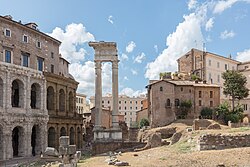
The Campus Martius was a publicly owned area of ancient Rome about 2 square kilometres in extent. In the Middle Ages, it was the most populous area of Rome. The IV rione of Rome, Campo Marzio, which covers a smaller section of the original area, bears the same name.

The Forum Boarium was the cattle market or forum venalium of ancient Rome. It was located on a level piece of land near the Tiber between the Capitoline, the Palatine and Aventine hills. As the site of the original docks of Rome and adjacent to the Pons Aemilius, the earliest stone bridge across the Tiber, the Forum Boarium experienced intense commercial activity.

The Forum Holitorium or Olitorium is an archaeological area of Rome, Italy, on the slopes of the Capitoline Hill. It was located outside the Carmental Gate in the Campus Martius, crowded between the cattle market and buildings located in the Circus Flaminius.

The Temple of Caesar or Temple of Divus Iulius, also known as Temple of the Deified Julius Caesar, delubrum, heroon or Temple of the Comet Star, is an ancient structure in the Roman Forum of Rome, Italy, located near the Regia and the Temple of Vesta.

The Theatre of Marcellus is an ancient open-air theatre in Rome, Italy, built in the closing years of the Roman Republic. At the theatre, locals and visitors alike were able to watch performances of drama and song. Today its ancient edifice in the rione of Sant'Angelo, Rome, once again provides one of the city's many popular spectacles or tourist sites. Space for the theatre was cleared by Julius Caesar, who was murdered before its construction could begin; the theatre was advanced enough by 17 BC that part of the celebration of the ludi saeculares took place within the theatre; it was completed in 13 BC and formally inaugurated in 12 BC by Augustus, named after his nephew Marcus Claudius Marcellus who had died in 23 BC.
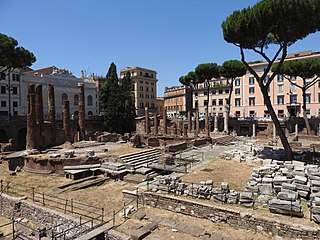
Largo di Torre Argentina is a large open space in Rome, Italy, with four Roman Republican temples and the remains of Pompey's Theatre. It is in the ancient Campus Martius.
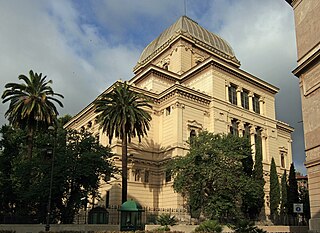
Sant'Angelo is the 11th rione of Rome, Italy, located in Municipio I. Often written as rione XI - Sant'Angelo, it has a coat of arms with an angel on a red background, holding a palm branch in its left hand. In another version, the angel holds a sword in its right hand and a scale in its left.

The Porticus Octaviae is an ancient structure in Rome. The colonnaded walks of the portico enclosed the Temples of Juno Regina (north) and Jupiter Stator (south), as well as a library. The structure was used as a fish market from the medieval period up to the end of the 19th century.

The Porticus Octavia, also known as the Portico of Octavius, was a portico in ancient Rome built by Gnaeus Octavius in 168 BC to commemorate his capture of Perseus of Macedonia during the Third Macedonian War. It stood between the Theatre of Pompey and the Circus Flaminius beside the Porticus Metelli. Pliny describes it as a double portico with bronze Corinthian capitals, for which it was also called the Corinthian Portico. It may have been the earliest use of this architectural order in Rome and is possibly to be identified with remains on the Via S. Nicola ai Cesarini, represented in the Severan Marble Plan. Velleius Paterculus called it "by far the loveliest" of the porticoes of his time.
Gaius Sosius was a Roman general and politician who featured in the wars of the late Republic as a staunch supporter of Mark Antony. Under the latter's patronage he held important state offices and military commands, serving as governor of Syria and leading the expedition to install Herod as king of Judea. Sosius was consul in the year 32 BC, when the Second Triumvirate lapsed and open conflict erupted between the triumvirs Antony and Octavian. Upon taking office, Sosius opposed Octavian in the Senate, for which he was forced to flee Rome.
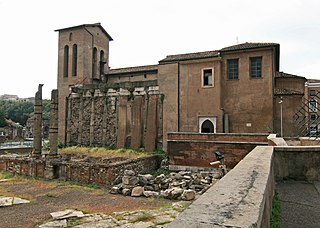
The Temple of Janus at the Forum Holitorium was a Roman temple dedicated to the god Janus, located between the Capitoline Hill and the Tiber River near the Circus Flaminius in the southern Campus Martius. The temple was built during the First Punic War, after the Temple of Janus in the Roman Forum.

The Temple of Apollo Palatinus, sometimes called the Temple of Actian Apollo, was a temple to the god Apollo in Rome, constructed on the Palatine Hill on the initiative of Augustus between 36 and 28 BCE. It was the first temple to Apollo within the city's ceremonial boundaries and the second of four temples constructed by Augustus. According to tradition, the site for the temple was chosen when it was struck by lightning, which was interpreted as a divine portent. Augustan writers situated the temple next to Augustus's personal residence, which has been controversially identified as the structure known as the domus Augusti.

The Temple of Bellona was an temple dedicated to the goddess of war Bellona in ancient Rome. It was located at the northern end of the Forum Olitorium, the Roman vegetable market, near the Carmental Gate. The Temple of Apollo Sosianus and the Theater of Marcellus were located nearby.
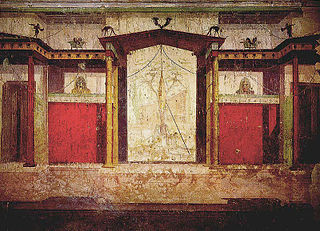
The House of Augustus, or the Domus Augusti, is situated on the Palatine Hill in Rome, Italy. This house has been identified as the primary place of residence for the emperor Augustus.
During the Middle Ages, Rome was divided into a number of administrative regions, usually numbering between twelve and fourteen, which changed over time.

The Regio IX Circus Flaminius is the ninth regio of imperial Rome, under Augustus's administrative reform. Regio IX took its name from the racecourse located in the southern end of the Campus Martius, close to Tiber Island.
The Arch of Germanicus was an arch of Rome situated at the northern end of the Circus Flaminius.





